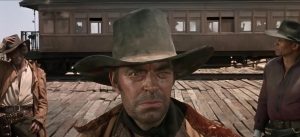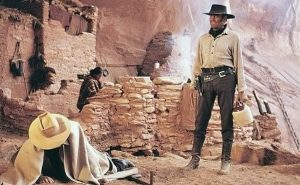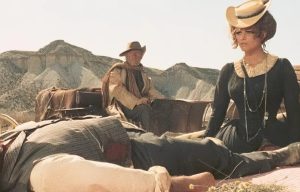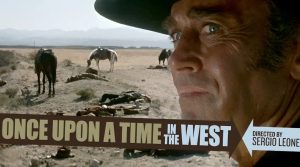Once Upon a Time in the West (1968) is an epic Spaghetti Western directed by Sergio Leone, starring Henry Fonda, Charles Bronson, Claudia Cardinale, and Jason Robards. Widely regarded as a masterpiece of the genre, the film weaves a story of revenge, greed, and survival against the sprawling backdrop of the American frontier. Ennio Morricone’s iconic score, combined with Leone’s masterful direction, makes this a landmark in cinematic history.
Plot Overview
The story centers on a mysterious harmonica-playing gunslinger (Charles Bronson), simply known as Harmonica, who seeks revenge against the ruthless Frank (Henry Fonda). Frank, a cold-blooded killer working for a corrupt railroad tycoon, becomes entangled with Jill McBain (Claudia Cardinale), a widow determined to protect her late husband’s land, which holds strategic value for the railroad’s expansion. With the help of a bandit named Cheyenne (Jason Robards), Harmonica and Jill confront Frank and unravel a tale of betrayal, vengeance, and redemption.
Performances
Henry Fonda delivers an unforgettable performance as Frank, portraying one of the most chilling villains in Western cinema. His casting against type enhances the impact of his ruthless character. Charles Bronson embodies Harmonica’s stoic determination, while Claudia Cardinale’s portrayal of Jill adds emotional depth and strength to the story. Jason Robards brings wit and grit to Cheyenne, creating a memorable and complex outlaw.

Cinematic Elements
Sergio Leone’s direction is a tour de force, with his signature use of long takes, dramatic close-ups, and expansive landscapes. The film’s visual storytelling is complemented by Ennio Morricone’s haunting score, which uses character-specific musical motifs to heighten the emotional impact. The cinematography, by Tonino Delli Colli, captures the grandeur and harshness of the American West, creating a sense of both beauty and desolation.

Themes and Impact
Once Upon a Time in the West explores themes of progress, revenge, and the decline of the traditional West. It critiques the romanticized view of the frontier, presenting a harsher and more realistic portrayal of the era. The film’s deliberate pacing and intricate character dynamics create a layered narrative that continues to influence the Western genre and modern filmmaking.

Flaws
The film’s slow pacing and extended runtime may not appeal to all viewers, particularly those unfamiliar with Sergio Leone’s style. Additionally, its complex narrative and lack of overt exposition require close attention, which might deter casual audiences.
Conclusion
Overall, Once Upon a Time in the West (1968) is a cinematic triumph that combines unforgettable performances, masterful direction, and an iconic score. For fans of Westerns or those seeking a rich and visually stunning film, it remains an essential classic.

